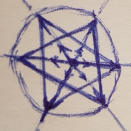-
Posts
10567 -
Joined
-
Last visited
-
Days Won
2
ydoaPs last won the day on September 22 2021
ydoaPs had the most liked content!
About ydoaPs

- Birthday 04/21/1988
Profile Information
-
Location
Local Group
-
College Major/Degree
BA in Philosophy
-
Favorite Area of Science
Physics
-
Biography
Grad school dropout and stay at home dad
-
Occupation
Stay at home dad
Retained
- The Oncoming Storm
Recent Profile Visitors
100924 profile views
ydoaPs's Achievements

SuperNerd (12/13)
1.6k
Reputation
-
When you're talking about volumes and hypervolumes, your set needs to be equipped with a measure function. The technicalities are too much to go into in a single post, but see the wiki link if you're interested. The standard measure used on the Reals is the Lebesgue measure where the length (in one dimension) is just the difference of the endpoints. So, if we're looking at the length of a point p, we need to just take p-p, which is, of course, 0.
-
It depends on the kind of classical physics and the complexity. If you want to understand basic toy kinematics and dynamics at the high school level, you could get away with going up to the first order differential equations. You'll be doing stuff like taking the derivative of a displacement equation to get a velocity equation. If you want to understand more complex problems with more modern paradigms, then you'll need multivariable calculus. You'll be doing things like solving the Euler-Lagrange equations and integrating Lagrangians to find the least action. With waves, electromagnetism, and "Modern Physics", that table of contents specifically tells me you'll likely need the multivariable parts of the calculus text as well. But it might be simplified for like an introductory course. You'll have to look at the physics book. If it has [math]\partial[/math] or an upside-down triangle,you know you'll need the multivariable parts. TL;DR: That physics book's topics suggest you'll need the entirety of the calculus book Edit: ! Moderator Note Topic moved from Lounge to Classical Physics
-

Can be that the Natural Numbers are Finite?
ydoaPs replied to Conscious Energy's topic in General Philosophy
It should be pointed out that this is an uncountabe infinity. It is waaaaaaaaaaaaaaay bigger than the infinite cardinality of the natural numbers Infinities come in different sizes -

Sign rule for multiplication
ydoaPs replied to neonwarrior's topic in Linear Algebra and Group Theory
Well thank you. It took some doing to fix my bbtex mistakes on the phone with autorendering -

Sign rule for multiplication
ydoaPs replied to neonwarrior's topic in Linear Algebra and Group Theory
It's good that you asked in Linear Algebra And Group Theory, because we're going to need some algebra you likely have never seen (unless you went to college) to answer it. Multiplication isn't one thing. What multiplication is depends on what you're multiplying. Algebra is how we define this. In Algebra, there are a handful of different kinds of structures. Here, we're interested in Groups, Rings, and Fields. Rings and Fields are kind of made of Groups, so we'll start there. Say we have a set (the lay concept of set will work fine for our purposes), and we'll call it S. On this set, we need to define a rule called a "binary relation" that takes any two things in the set and gives some output. We want this set to be closed under this relation, so the relation can only give us things that are already in the set. For this combination of set and relation (for now, we'll use ? to denote the relation) to be a Group, they need to have the following properties: 1) Associativity: for any three things a, b, and c in the set, the relation doesn't care about where the parentheses go. a?(b?c)=(a?b)?c 2) Identity: there is a special thing in the set (traditionally denoted by e when talking abstractly) where, for any other thing a in the set, a?e=e?a=a 3) Invertability: for any thing a in the set, there is another thing in the set a* where a?a*=e=a* That's enough to be a Group. But we want a special kind of Group, called an Abelian Group. That's just a regular Group that has an extra property: 4) Commutativity: for any two things a and b in the set, a?b=b?a Tradition dictates that for Abelian Groups, + is used in place of ? and 0 is used in place of e and -a in place of a*. If a Group is not Abelian, we often use × (or nothing at all) in place of ? and 1 in place of e and 1/a in place of a*. If S is the set, we write (S, +) or (S, ×) for the group, but we often just write S if it is clear from the context that we're talking about a group. This is enough to let us build a Ring. With Rings, we still have a set S, but we have two relations. (S, +) is an Abelian Group, but × is a bit more lax. × only has to satisfy two properties: 1) Identity, and 2) Distributivity: for any three things a, b, and c in S, a×(b+c)=(a×b)+(a×c) Like how (S, ?) is a Group, (S, +, ×) is a Ring. If a Ring is commutative and has inverses for each relation, then the Ring is called a Field. There are four particularly important facts mentioned above that are important to why a negative times a negative is a positive: 1) a+(-a)=0, 2) a+0=a, 3) a×0=0 (not mentioned above, but still important), and 4) a×(b+c)=(a×b)+(a×c) Proof -a×-b = a×b: Let a and b be positive numbers in our field (S, +, ×). 0=b+(-b)=a(b+(-b)) -a×-b = (-a×-b) + a(b+(-b)) = -a×-b + a×b + a×-b = -a×-b + a×-b + a×b = -b×a + -b×-a +a×b = -b(a+(-a)) + a×b = a×b TL;DR: It's because Fields are commutative, have identities, and are distributive -
And that's not even counting all of the other forms of sameness like adjoint situations. There's so many different forms of "eh, that's sort of the same as this other thing in certain ways".
-
What LaTeX packages can we use in blogs? If the one we need (say, for commutative diagrams) isn't installed, is there a way to get it installed?
-
If I'm understanding you correctly, I think you're using different terminology. It might be a geographic thing. As far as I learned, an Equivalence Relation has the properties you detailed in your post, and, by the process I discussed, partitions a set into Equivalence Classes resulting in the quotient set (or monoid or group or category etc). I'm not sure what there is to gain by using "equivalence" only in terms of equivalence classes rather than for either equivalence relations and equivalence classes. If we had to pick, I'd probably make the relation "Equivalence", but that's probably just the categorial bias I have.
-
Jesus also got mad when a fig tree didn't produce figs when it was not fig season.
-
That's a great post. Yeah, equivalence relations are much looser than identity. Any bivalent relation will give you an equivalence relation. You can actually even define an equivalence relation out of any function. Take a function f, and you can define the equivalence relation ~ such that a~b iff f(a)~f(b). This is part of a process of decomposing a function. If the domain (what the function is taking as an argument) is A, and the the codomain (what the function points to) is B, then you can decompose a function via ~ in the following way. Make a function f* that takes A and maps each element to the set of other elements of A that it is equivalent to under ~. So, an a in A maps under f* to all of the other a's that map to the same thing under f. For example, take the rule for f to be f(x) = x2. f*, then, will map 1 to {-1, 1}, 2 to {-2, 2}, 3 to {-3, 3} etc, because -1 and 1 both go to the same place under f. We typically write the codomain of f* as A/~. You can then go from A/~ to what is called the "image" of f. And that's just the collection of things in B that actually get pointed to from things in A by f. Often you'll see this just imf. So we have A -> A/~ -> imf. But there's something neat here. Since we have in essence collapsed A into things that don't map to the same thing in imf and all of the things in imf get mapped to, this function is reversible. So we have A -> A/~ <-> imf. Since it goes back and forth like that (assuming the function is structure preserving), A/~ and imf are isomorphic. That's a big word for "for all current intents and purposes, they're the same structurally". A nice fact about isomorphisms is that they are all equivalence relations. We can go further into canonical decomposition and go from imf to B, but, for our purposes, we've gotten what we need for this discussion. Any function gives us two different equivalence relations. So in our example of f(x) = x2 from the Real numbers to the Real numbers, we get the Real numbers being equivalent to sets of Real numbers that have the same absolute value. Those clearly aren't the same thing, in terms of identity. We also get this set of sets of numbers with the same absolute value being equivalent to the set of the squares of the absolute values of the previously mentioned set. Clearly sets containing things like {-2, 2} and sets containing things like 4 aren't identical, but they are equivalent. Any nice back and forth will satisfy the axioms for the equivalence relation. Identity, on the other hand, has extra cool stuff like substitution. Identity is much stronger than equivalence.
-
How many coin flips does it take to make a free choice?
-
You'll need to define a function; do you know how? You'll need to take an input from the user; Do you know how? You'll need to make sure the data type of the input is a certain type; do you know what type that is and how to check that the input is that type? Then you'll need to perform the calculation and print the result; Do you know how? Give it a shot, and if you can't figure out how to do any of the above steps, let us know. We won't do your homework for you, but we'll help you figure it out.
-
That's kind of the definition of UFO.
-

How does one represent the fourth dimension on a graph?
ydoaPs replied to thethinkertank's topic in Relativity
You could map the wavelengths of visible light to [0,1], map [0,1] to some continuous subset of your time variable, then do a graph for different colors (points in time) for any "granularity" of colors (moments) that you'd like.






